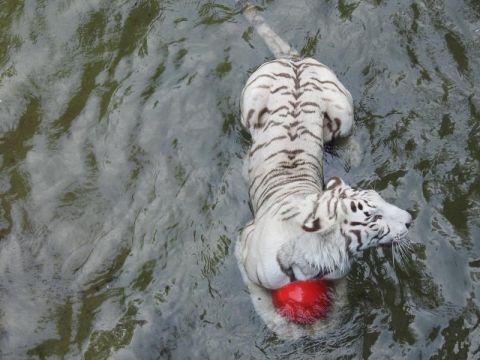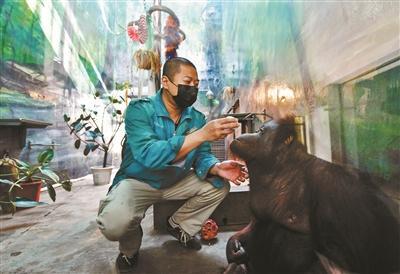The white tiger "pacing in circles" in Beijing Zoo attracted the attention of the person in charge of the feeding team and responded that it was not necessarily related to animal welfare.
Recently, a video of a white tiger walking in a circle in Beijing Zoo was circulated on the Internet. Is this white tiger sick? Is the animal welfare provided by the garden relatively poor? Related speculation has aroused the concern and worry of some netizens. In this regard, Beijing Youth Daily reporter interviewed Zhang Yizhuo, the head of the feeding team of Beijing Zoo, to learn about the latest progress of the incident and the related situation of animal welfare and health management in Beijing Zoo.
"White Tiger Circle" is a short-term
The routine that appears is
Beiqing Daily: Recently, a video of a white tiger "walking in circles" in Beijing Zoo was circulated on the Internet, which aroused public concern. Why is this happening?
Zhang Yizhuo: In animal behavior, this is called "pacing behavior". The reasons for the pacing behavior of animals are complicated. Even if the living environment is acceptable, it may be stimulated by some kind, such as special smells and sounds, which will also induce the pacing behavior of animals.
Last summer, the breeder discovered this phenomenon. What appears in the video is a male Bengal white tiger, which was introduced to Beijing Zoo in 2018 and is now about five years old. There are 9 animals in Shihu Mountain of Beijing Zoo. Only this white tiger appears pacing, which is a routine in a short time. We are continuing to track and analyze the reasons behind it.
At the same time, Beijing Zoo has taken a number of environmental enrichment measures. For example, adding props such as rubber cones to hide meat inside makes it more difficult to eat; Fill the pool of the outdoor sports ground with water and add floating wooden frames. After enriching the living environment, animals can be provided with more diversified choices, and the opportunities for their natural behavior will increase.

Abnormal behavior and animal welfare level
There is no necessary correlation
Beiqing Daily: Some netizens expressed concern that the animal welfare provided by the garden was poor and the white tiger was ill. What do you think of this?
Zhang Yizhuo: Veterinarians in Beijing Zoo will regularly check the animals in the park. At present, this white tiger’s physical state and mental state are normal, and its eating and defecation are also normal. It eats about 8 Jin of meat every day, including beef and lamb chops.
Animal welfare is a concept introduced from abroad, and it has been less than 20 years since domestic zoos really started relevant work. At first, domestic zoos were basically designed as cement floors and iron railings for the convenience of cleaning. It was not until 2002 that foreign experts came to Beijing Zoo to hold the first symposium on environmental abundance that people first came into contact with the concept of "environmental abundance". Environmental enrichment is an important measure to improve animal welfare. By improving the captive environment, healthy wild animals can be stimulated to show a series of natural behaviors, and their physical and mental health can be promoted.
Animal behavior is influenced by many factors, and there is no necessary correlation between abnormal behavior and animal welfare level. Studies abroad have found that the abnormal behavior of giant pandas increases when they move to a new environment or are intimidated or disturbed by tourists, but the welfare level of animals has not decreased through welfare assessment.
Beijing Zoo has always taken the promotion of animal welfare as its working goal, and the capital investment is also increasing continuously, which is used to create better living conditions for animals, including transforming exhibition venues, increasing nutrition supply, improving health management, carrying out environmental enrichment and behavior training, etc., all of which can meet the welfare needs of animals. For example, last year, the outdoor sports ground of black muntjac was renovated and hedgerows were added to make animals feel more secure; This year, it is planned to increase the sports facilities of the Red Panda Pavilion, add shade awnings to the polar bear stadium, and add ceilings to the gibbon outdoor venues.
The zoo has put the white tiger
Take environmental enrichment measures and behavior training.
Beiqing Daily: If animals behave abnormally in the short term, to what extent can improving animal welfare be improved?
Zhang yizhuo: environmental abundance can reduce the probability of abnormal behavior to a certain extent, but it can’t solve all abnormal behavior problems 100%. For example, a giant panda once vomited, and after vomiting, it would quickly eat the vomit. At present, the industry has not yet studied the causes of this behavior. But if some tourists see this scene, they will feel uncomfortable. In order to solve this problem, we carried out behavior training for giant pandas, sent special personnel to clean up vomit in time, and rewarded giant pandas who didn’t eat vomit, such as providing them with their favorite food. Now this situation will not happen again.
However, different species have different responses to environmental enrichment measures. For this white tiger with abnormal behavior, we are taking various environmental enrichment measures and animal behavior training, and the frequency of pacing behavior has eased at present. We will continue to inquire about relevant information, contact experts at home and abroad, and help us solve this problem together, expecting better results.

related news
New tricks of epidemic prevention used in smoking moxibustion and smelling sachets zoo
Yesterday, the reporter of Beiqing Daily came to the backstage of the orangutan hall in Beijing Zoo. As soon as he entered the corridor, he smelled the strong smell of fumigation and moxibustion. "Since the outbreak, we have used this method to disinfect the breeding background with air fumigation every day." Wang Zheng, a technician in the orangutan hall of Beijing Zoo, disinfected once every morning and afternoon. "Put a moxa stick at the entrance and exit of the corridor and in the middle of the corridor, and the average burning time can reach about 40 minutes. Animals have no obvious reaction to the burning smell of wormwood."
With years of knowledge accumulation, Wang Zheng also made a sachet of traditional Chinese medicine for animals, which contained more than ten kinds of traditional Chinese medicines such as atractylodes rhizome, angelica dahurica, mugwort leaf, Artemisia annua and tsaoko. Not only do breeders wear them with them, but they also smell them to animals. "This can achieve the common epidemic prevention function of people and animals."
In the orangutan hall, there lived an orangutan "Pangpang". It’s the "post-80s generation" and it’s 33 years old this year. More than a decade ago, the "chubby" hind limbs showed symptoms of walking difficulties. In the worst case, it can only crawl on the ground and get enough food by its mouth.
Wang Zheng innovatively introduced Chinese medicine massage and rehabilitation physiotherapy. "At first, I used the meridian detection activation instrument to determine the position of important acupuncture points for’ Pangpang’ against the human acupoint map. After repeated experiments, 19 acupoints were finally determined. " Wang Zheng said that since 2017, he and his colleagues have insisted on doing Chinese medicine rehabilitation training for "chubby" every day. At present, the physical condition of "Pangpang" has been obviously improved, and the flexibility of upper limbs and the strength of lower limbs have been enhanced. It can move freely in the exhibition room by relying on its two forelimbs.
"All the work we do is to improve animal welfare." Wang Zheng said that in the zoo, all animals are equal and have the right to happiness.
Text/Beijing Youth Daily reporter Wang Bin Photography/Beijing Youth Daily reporter Yuan Yi
Reporting/feedback